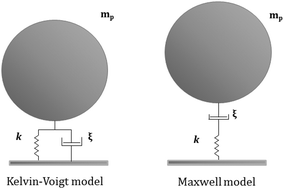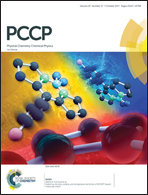Elastic and viscous bond components in the adhesion of colloidal particles and fibrillated streptococci to QCM-D crystal surfaces with different hydrophobicities using Kelvin–Voigt and Maxwell models
Abstract
A quartz-crystal-microbalance with dissipation (QCM-D) can measure molecular mass adsorption as well as register adhesion of colloidal particles. However, analysis of the QCM-D output to quantitatively analyze adhesion of (bio)colloids to obtain viscoelastic bond properties is still a subject of debate. Here, we analyze the QCM-D output to analyze the bond between two hydrophilic streptococcal strains 91 nm long and without fibrillar surface appendages and micron-sized hydrophobic polystyrene particles on QCM-D crystal surfaces with different hydrophobicities, using the Kelvin–Voigt model and the Maxwell model. A Poisson distribution was implemented in order to determine the possible virtues of including polydispersity when fitting model parameters to the data. The quality of the fits did not indicate whether the Kelvin–Voigt or the Maxwell model is preferable and only polydispersity in spring-constants improved the fit for polystyrene particles. The Kelvin–Voigt and Maxwell models both yielded higher spring-constants for the bald streptococcus than for the fibrillated one. In both models, the drag coefficients increased for the bald streptococcus with the ratio of electron-donating over electron-accepting parameters of the crystal surface, while for the fibrillated strain the drag coefficient was similar on all crystal surfaces. Combined with the propensity of fibrillated streptococci to bind to the sensor crystal as a coupled-resonator above the crystal surface, this suggests that the drag experienced by resonator-coupled, hydrophilic particles is more influenced by the viscosity of the bulk water than by interfacial water adjacent to the crystal surface. Hydrophilic particles that lack a surface tether are mass-coupled just above the crystal surface and accordingly probe the drag due to the thin layer of interfacial water that is differently structured on hydrophobic and hydrophilic surfaces. Hydrophobic particles without a surface tether are also mass-coupled, but their drag coefficient decreases when the ratio of electron-donating over electron-accepting parameters increases, suggesting that hydrophobic particles experience less drag due to the structured water adjacent to the surface.



 Please wait while we load your content...
Please wait while we load your content...